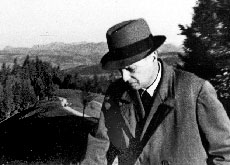A man made in Switzerland

The artist Paul Klee may have died a German but the man had "made in Switzerland" stamped all over him.
Born and raised in canton Bern and a fluent speaker of Swiss German, he made the Swiss capital his home once more after being ousted from a teaching post in Germany by the Nazis.
Klee was born on December 18, 1879, in Münchenbuchsee to the Swiss Ida Frick and the German Hans Klee.
Paul had a sister, Mathilde, his elder by three years, and had the same nationality as his father.
Early beginnings
Legend has it that it was his Swiss maternal grandmother who first encouraged his artistic bent by giving him colouring pencils and paper when he was three or four years old.
As an adult, Klee said that his artistic journey began during these tender years and he counted some of the drawings he did as a child as part of his works.
Later as an older child and adolescent, the young Klee’s sketches reveal an interest in his surroundings.
He drew Bernese landscapes and took his sketchbook along when he visited relatives or went on trips with his father within Switzerland.
When not drawing, playing the violin and writing poems, Klee went to the Progymnasium school in the heart of Bern. He was far from being a model student and scraped through his school-leaving exams in 1898.
He wrote later in his diary: “I would have gladly left school during the last year but one, but my parents were against it… I… felt like a martyr, I only liked doing what I was not allowed to do – drawing and writing.”
His parents wanted him to embark on a musical career but he had other plans.
Just two months after his school-leaving exam, he left home for the German town of Munich to study drawing at a private art school.
Homecoming
Klee spent four years away. It was an eventful hiatus – he completed his formal studies in art, met and became engaged to his future wife, and visited Italy.
In 1902 he returned to Bern, moving back into his parents’ home. He began to earn his keep by playing in concerts and writing theatre reviews, while continuing to teach himself to draw.
Between 1903-05, Klee made two leaps in his artistic development. He began experimenting with etching, which resulted in a cycle of 11 etchings.
He also developed a process, which involved drawing with a needle on a blackened pane of glass, and created almost 60 drawings using this method.
A year later in 1906, Klee made his second substantial break with Switzerland by marrying Munich-based pianist, Lily Stumpf, and moving to her hometown.
However, he did not abandon Bern altogether. After the birth of son Felix in 1907, Paul frequently returned to his parents’ house with his child, often for months at a time, while Lily worked to keep the home together by giving piano lessons.
Paul’s letters during this time suggest he enjoyed being in Bern; these sojourns allowed him to pursue his own activities while his family looked after Felix.
Coming home… again
After nearly 30 years abroad, the artist made Switzerland his home again in December 1933, albeit somewhat reluctantly.
Klee’s fortunes had turned with the rise of National Socialism in Germany.
Having found fame as an artist, generating a tidy income from the sales of his works and drawing a good salary as an art professor, Klee became a persona non grata almost overnight.
Termed a degenerate artist by the Nazis, with all his works removed from public galleries in Germany, Paul sought refuge in Bern with his family.
In the provincial Swiss capital, far from the bohemian figures and intellectual excitement that had coloured his middle years, the fall from grace must have seemed complete.
After a peripatetic few months, Paul and his wife Lily moved into a two-bedroom flat in Kistlerweg in Bern’s leafy Elfenau quarter.
From their balcony, they could sometimes make out the tips of the mountains in the Bernese Oberland.
One room was dubbed Lily’s music room and another Paul’s atelier. It was here that he was inspired to create more than 2,700 works.
In the last few years of his life, Paul made a number of applications for Swiss citizenships but was unsuccessful each time.
The first time, he did not fulfil the residency requirements and he did not live to see the outcome of his final attempt.
Decline
The return to his modest beginnings was accompanied by a deterioration in his physical condition.
Plagued by stomach problems, Klee suffered from weight loss and hardening of the skin. Towards the end of his life, he had difficulty swallowing and was incontinent.
But his doctors failed to diagnose Klee’s true condition, which has since been identified as scleroderma, an incurable autoimmune disease.
The end for the Swiss artist with a German passport came in canton Ticino.
After taking cures in a number of sanatoriums, Klee died on June 29, 1940, in a clinic in Locarno-Muralto in southern Switzerland.
Six days after his death, the authorities finally granted Klee Swiss nationality.
His wife Lily took his ashes home to Kistlerweg and kept them in an urn in his atelier until her own death in 1946.
swissinfo, Faryal Mirza
Paul Klee spent more than three decades of his life in Switzerland.
Born in Münchenbuchsee, Bern, on December 18, 1879, Klee died on June 29, 1940, in Locarno-Muralto in canton Ticino.
He spoke Swiss German dialect like a native, while his High German had a Bernese accent.
Klee was granted Swiss nationality six days after his death.

In compliance with the JTI standards
More: SWI swissinfo.ch certified by the Journalism Trust Initiative








You can find an overview of ongoing debates with our journalists here . Please join us!
If you want to start a conversation about a topic raised in this article or want to report factual errors, email us at english@swissinfo.ch.